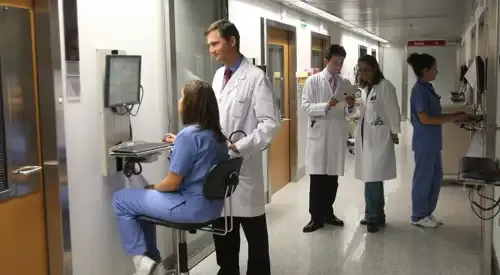Sarcoidosis
"It is necessary to carry out a periodic follow-up of the patient with sarcoidosis that allows the treatment to be started or modified at any given time".
DR. CARLOS CABANYES
SPECIALIST. INTERNAL MEDICINE DEPARTMENT

What is sarcoidosis?
Sarcoidosis is a systemic disease characterized by the accumulation of noncasifying granulomas (formed by T lymphocytes and macrophages) that distort the tissue structure of the organ where they settle and alter its function.
It affects multiple organs of the body essentially the lungs and lymph nodes. In addition, it can affect the skin, eyes, joints, liver, heart ...
The cause of the disease is currently unknown although different possibilities have been considered: infectious agents (viruses, mycobacteria and fungi), environmental, genetic.
The disease is associated with an abnormal immune response but it is not known why this response is triggered.

What are the symptoms of sarcoidosis?
The symptoms of the disease can be produced by active or residual disease. Many patients do not report any discomfort and are diagnosed by chance for another reason. However, most patients debut with general symptoms such as fatigue, loss of appetite and weight, or fever.
A large number also report back pain, coughing and shortness of breath, given the frequent lung involvement of the disease. Other symptoms that may appear are related to the target organ of the disease, which otherwise can be anyone.
In 25% of the cases, non-specific or specific skin lesions appear, such as lupus pernium (indurated violet lesions located on the cheeks, nose, lips and ears).
Erythema nodosum is often associated with hilar adenopathies constituting the so-called Löfgren's syndrome, frequently associated with fever, arthralgias, arthritis and acute uveitis. 5% of patients have cardiac involvement. It can produce from simple unspecific alterations in the electrocardiogram to heart failure and sudden death.
The most common symptoms are:
- Fatigue.
- Loss of appetite and weight.
- Fever.
- Cough.
The sarcoidosis can affect to any part of the nervous system, but the most frequent symptom is the peripheral facial paralysis that associated to ocular affectation and increase of the parotid glands constitutes the syndrome of Heerfördt.
Others: arthralgias, arthritis, digestive problems, hepatic dysfunction, hypercalcemia, etc.
Do you have any of these symptoms?
You may have sarcoidosis
What is your prognosis for sarcoidosis?
The disease remits or improves in many patients without treatment. There is a classification in four stages (0 to III) based on the existence or not of hilar adenopathies or pulmonary affectation, which allows predicting to a certain extent the evolution, worse in stage III.
In the same way that there are no specific tests for the diagnosis, there is also none that allows the evolution of the disease to be clearly established, hence the need for periodic follow-up of the patient, which allows treatment to be initiated or modified at a given moment.
Who can get sarcoidosis?
Its distribution is universal, with preference for adults under 40 years of age and a slight predominance of females.
How is sarcoidosis diagnosed?

It is necessary to determine in each patient who presents sarcoidosis the sites and severity of granulomatous involvement in the various organs and systems that can compromise life.
Although clinical presentation may lead to a suspicious diagnosis of sarcoidosis, it is necessary to confirm it by biopsy, knowing that the presence of noncasing granulomas is not exclusive to this disease.
No specific laboratory or radiological test is currently available.
In order to make a definitive diagnosis of sarcoidosis, it is necessary to rule out other diseases that may appear similar but require different treatments.
How is sarcoidosis treated?
The treatment is based primarily on the use of steroids.
Initially the patient can be observed without treatment. In general, it can be said that corticoid treatment should be initiated in the face of severe eye symptoms, neurological affectation, cardiac sarcoidosis, hypercalcemia or progressive pulmonary disease.
Other treatment options include methotrexate and hydrochloroquine.
Where do we treat it?
IN NAVARRA AND MADRID
The Department of Internal Medicine
of the Clínica Universidad de Navarra
Its integrative vision and polyvalence allow us to provide the best medical assistance to multipathological and multisymptomatic patients, who present a difficult diagnosis or who suffer from prevalent diseases of a hospital nature.

Why at the Clínica?
- State-of-the-art diagnostic technology.
- Quick diagnosis to start the most appropriate treatment early.
- Teamwork with the rest of the professionals in the Clinic.




























